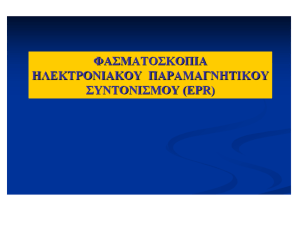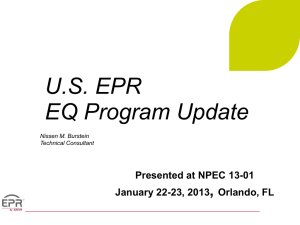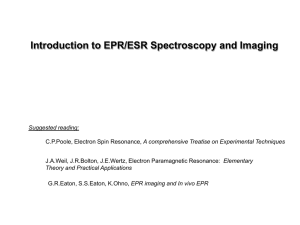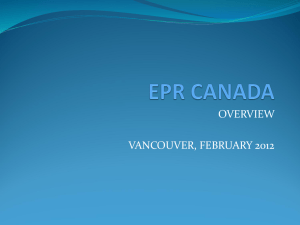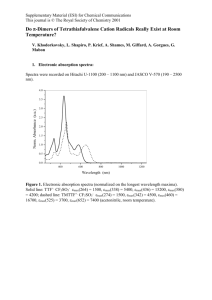592082_1_data_set_6709011
advertisement
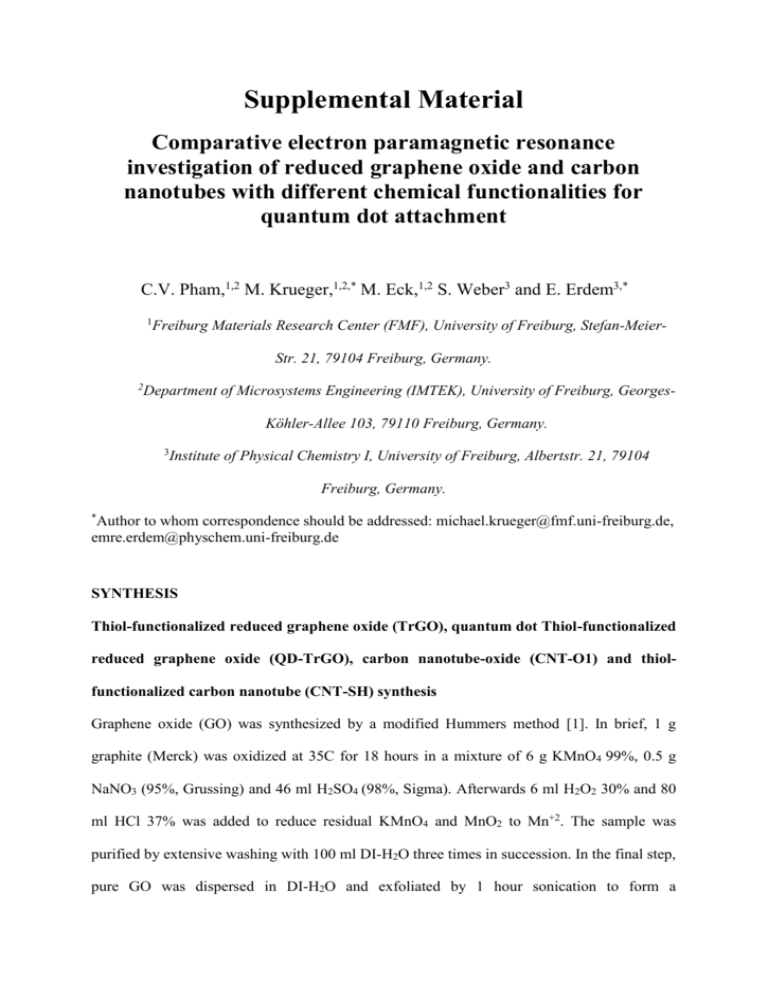
Supplemental Material Comparative electron paramagnetic resonance investigation of reduced graphene oxide and carbon nanotubes with different chemical functionalities for quantum dot attachment C.V. Pham,1,2 M. Krueger,1,2,* M. Eck,1,2 S. Weber3 and E. Erdem3,* 1 Freiburg Materials Research Center (FMF), University of Freiburg, Stefan-MeierStr. 21, 79104 Freiburg, Germany. 2 Department of Microsystems Engineering (IMTEK), University of Freiburg, GeorgesKöhler-Allee 103, 79110 Freiburg, Germany. 3 Institute of Physical Chemistry I, University of Freiburg, Albertstr. 21, 79104 Freiburg, Germany. * Author to whom correspondence should be addressed: michael.krueger@fmf.uni-freiburg.de, emre.erdem@physchem.uni-freiburg.de SYNTHESIS Thiol-functionalized reduced graphene oxide (TrGO), quantum dot Thiol-functionalized reduced graphene oxide (QD-TrGO), carbon nanotube-oxide (CNT-O1) and thiolfunctionalized carbon nanotube (CNT-SH) synthesis Graphene oxide (GO) was synthesized by a modified Hummers method [1]. In brief, 1 g graphite (Merck) was oxidized at 35C for 18 hours in a mixture of 6 g KMnO4 99%, 0.5 g NaNO3 (95%, Grussing) and 46 ml H2SO4 (98%, Sigma). Afterwards 6 ml H2O2 30% and 80 ml HCl 37% was added to reduce residual KMnO4 and MnO2 to Mn+2. The sample was purified by extensive washing with 100 ml DI-H2O three times in succession. In the final step, pure GO was dispersed in DI-H2O and exfoliated by 1 hour sonication to form a homogeneous solution. Consequently the exfoliated GO was collected by vacuum evaporation using a rotating evaporator at 70 C. GO was thiol-functionalized into TrGO by refluxing 100 mg as-received dried GO with 300 mg phosphorus pentasulfide (P4S10) (99%, Sigma) in 100 ml dimethylformamide (DMF) (HPLC reagent grade, Scharlau Chemie) at 154C for 24 h as reported elsewhere [2]. CdSe QDs were synthesized based on a procedure described by Yuan et al. [3] The resulting CdSe QDs have an average diameter of about 6 nm. QD-TrGO was fabricated by a self-assembly decoration as reported in a previous publication [2]. CNT-O1 and CNT-SH were synthesized following the same procedures as described for GO and TrGO, respectively. Carbon nanotube (CNT-O2) and Reduced graphene oxide (rGO) synthesis 200 mg CNT (Bayer Material Science, >99%) was added in mixture of 10 ml HNO3 (Merck, 63%) and 30 ml concentrated H2SO4 (Merck, 98%) and stirred at 100C for 4 h. The dispersion was then poured into 150 ml DI-H2O. After that CNT-O2 was collected by centrifugation at 4400 rpm for 2 h, and then purified by 3 times washing with 100 ml DI-H2O. Finally CNT-O2 was dried overnight in vacuum at room temperature. Reduced graphene oxide (rGO) was synthesized by reducing GO by hydrazine (N2H4) in DMF: 20 mg GO was dispersed in 50 ml DMF by sonication for at least 30 minutes. After 20 µl N2H4 (Sigma, 64%) was added and the dispersion was stirred at 90 oC for 12 h. The resulting rGO was then purified by centrifugation and re-dispersion three times in succession. EXPERIMENTAL Transmission electron microscopy (TEM, LEO 912 Omega) picture were recorded using an accelerated voltage of 120 kV. X-band (9.86 GHz) electron paramagnetic resonance (EPR) measurements were performed on a Bruker EMX spectrometer. The magnetic field was detected with an NMR gaussmeter (ER 035M, Bruker), and as a standard magnetic-field marker, polycrystalline diphenylpicrylhydrazyl (DPPH) with g = 2.0036 was used for accurate determination of the resonance magnetic-field values and the g-factor. Following EPR experimental parameters were used: microwave power: 1 mW, modulation amplitude: 0.5 G, time constant: 20.48 ms and receiver gain: 2x103. Time-depended photoluminescence (PL) quenching experiments were performed under following conditions: The as-received trioctylphosphine oxide (TOPO)/ hexadecylamine (HDA), TOPO/HDA, capped CdSe QDs were first post-synthetically treated with hexanoic acid in order to reduce the amount of surface ligands by applying a procedure reported in a previous publication [4]. Then 0.1 mg CdSe QD and 0.05 mg TrGO were added in 1 ml chlorobenzene (CB). Afterwards the QD and TrGO in CB dispersion were stirred with a magnetic stirring bar at 110 °C. The PL spectra of the QD-TrGO dispersion were recorded every two minutes by utilizing a J&M FL3095 spectrometer (J&M, Germany) using an excitation wavelength of 450 nm, band pass of 14.70 nm, integration time of 0.10 second; emission recorded range of (550 – 800) nm, increment 1.0 nm. For QD-rGO, the experiments were performed under the same condition as for QD-TrGO except using 0.05 mg rGO instead of TrGO. Transmission electron microscope (TEM) image: Figure S1. TEM image of CdSe quantum dot decorated thiol-functionalized reduced graphene oxide (TrGO). The upper inserted image has been taken at lower magnification revealing the QD attachment to the TrGO flake. Spin counting procedure: In order to accurately count the number of spins, there are many important issues that should be considered before and after the EPR experiment. Crucial issues, which have to be carefully taken into account, are: (i) Samples should be always weighed before the experiment to avoid complications due to different sample amounts in EPR tubes. If it is not possible to have always the same amount of sample in an EPR tube, then for normalization each spectrum should be multiplied by a filling factor (deduced from the mass of the sample in the EPR tube). (ii) The sample position should be always adjusted to the center of the microwave cavity. (iii) If there is a background EPR signal (e.g., from impurities in the resonator), it has to be subtracted from the EPR signal of the sample. (iv) One should always be careful not to saturate the EPR signal by applying too high microwave power. The microwave phase should be carefully adjusted during the critical coupling (tuning) of the resonator. (v) One has to check whether there is an offset in the magnetic field and calibrate if necessary. (vi) The Q value of the resonator has to be measured and all spectra should be referred to the same Q value. The number of defect centers can be quantitatively determined by the aid of EPR spectra independent from the microwave frequency. In order to calculate the defect concentration, one doubly integrates each EPR first-derivative signal. By comparing the integral of the standard sample (here, MnO powder) and the measured sample one obtains the corresponding number of spins, thus the concentration of defect centers. For an exact determination of defect concentration, one has to normalize by taking into account the following expression including experimental parameters of both the reference and the probe under investigation: (1) where NS*, RG, MF, MA, CT, P, Scans, SW, and S stand for the number of spins in reference sample, receiver-gain, modulation frequency (in kHz), modulation amplitude (in G), conversion time (in ms), microwave-power (in mW), field-sweep (in G), number of scans, and spin quantum number, respectively. Note that, (*) indicates the measurement parameters for the reference sample. Once the normalised-corrected value of NS* is obtained, via simple cross multiplication of the NS* and the area under the EPR signals reveal the defect concentration, ND, of the sample under investigation: (2) where (Area)D and ND are the area of the EPR signal of the related defect centre and the number of spins of the sample, respectively. In this work we used MnO powder as standard sample, which has 3.34 1019 spins/g. In Table I, the peak-to-peak width (∆Bpp) and the spin densities were given. The spin densities were calculated by spin-counting procedure which is described above: Table I: Peak-to-peak linewidth (∆Bpp) and the spin densities. Paramagnetism: Figure S2.Temperature dependence of the EPR-susceptibility as obtained after double integration of the obtained EPR spectra of a) CNT-O1 and b) TrGO. Quantitatively the measured EPR spectra can be analyzed in terms of double integration of the dispersive type continuous wave EPR which is given as EPR susceptibility. The related Curieplots were given in Figure S2. Obviously, the EPR line belong to CNT-O1 follows a ferromagnetic behaviour with a Curie temperature of TC = 222 K. In contrast, TrGO shows a more complicated behaviour. Below the EPR line of TrGO is temperature independent below TC (222 K) being characteristic for a Pauli paramagnetism. Between 222- 275 K interval the TrGO EPR line starts to tumble, which destroys the magnetic coupling of the electron spins which is reported recently for Fullerene anions [5]. PL spectra: Figure S3. PL spectra of CdSe QD, CdSe QD-TrGO nano-composites and a mixture of CdSe QD and rGO dissolved in chlorobenzene respectively, with the same QD concentrations (after 2 min of incubation). References: [1] a) W. S. Hummers and R.E. Offeman, J. Am. Chem. Soc 80, 1339 (1958). b) D.C. Marcano, D.V. Kosynkin, J.M. Berlin, A. Sinitskii, Z. Sun, A. Slesarev, L.B. Alemany, W. Lu, and J.M. Tour, ACS NANO 4, 4806 (2010). [2] C.V. Pham, M. Eck, and M. Krueger, Chemical Engineering Journal 231, 146 (2013). [3] Yuan Y, Riehle FS, Gu H, Thomann R, Urban G, and Krüger M, J Nanosci Nanotechnol 10, 6041 (2010). [4] Y. Zhou, F.-S. Riehle, Y. Yuan, H.-F. Schleiermacher, M. Niggemann, G. A. Urban, M. Kruger, Appl. Phys. Lett. 96, 13304 (2010). [5] M. B. Boeddinghaus, W. Klein, B. Wahl, P. Jakes, R.-A. Eichel, T. F. Fässler, Z. Anorg. Allg. Chem. (in print, 2014, online available) doi: DOI: 10.1002/zaac.201300607
